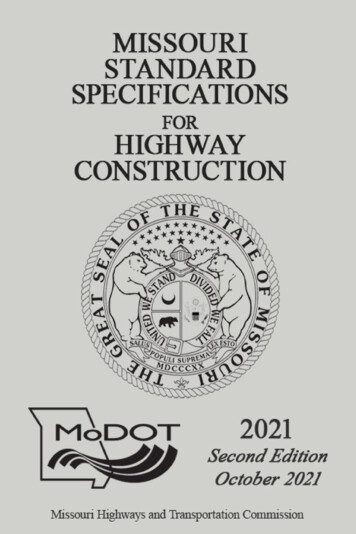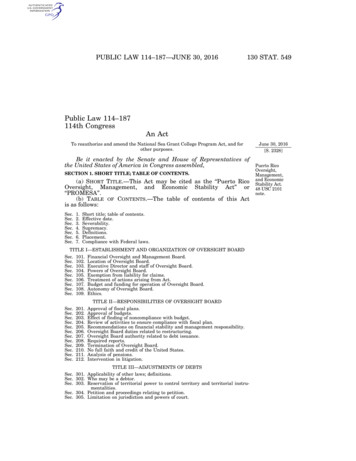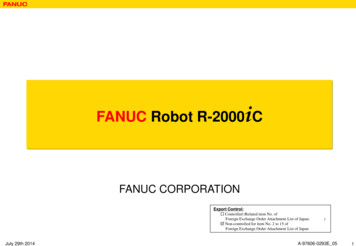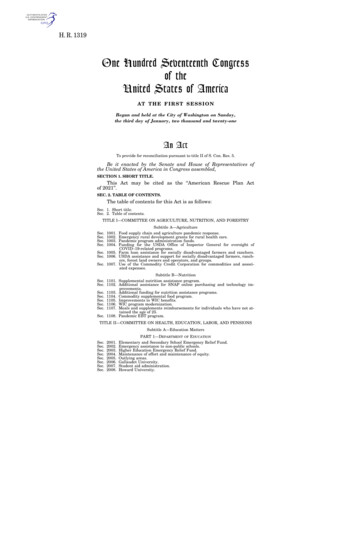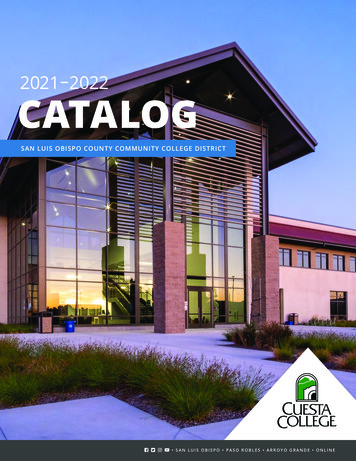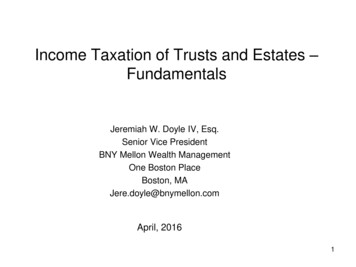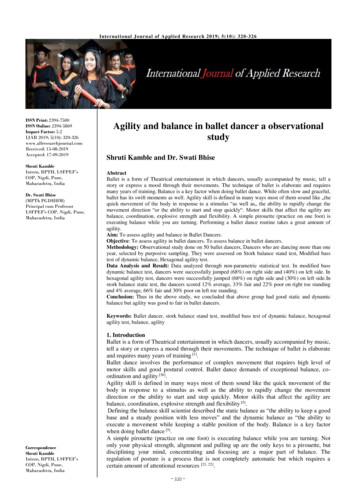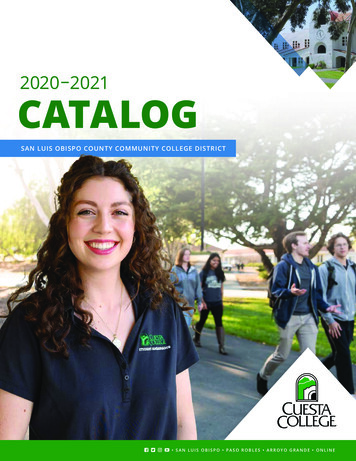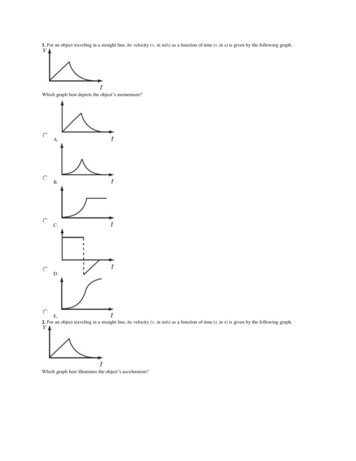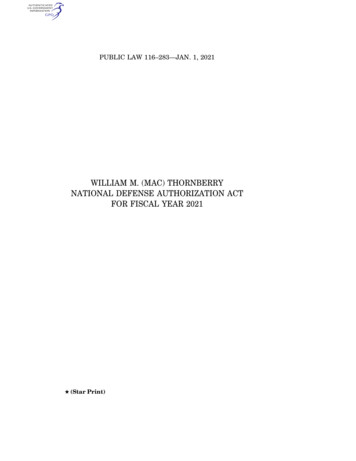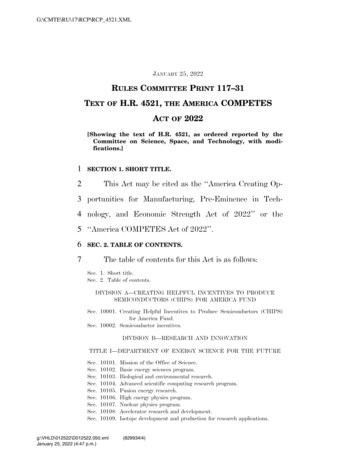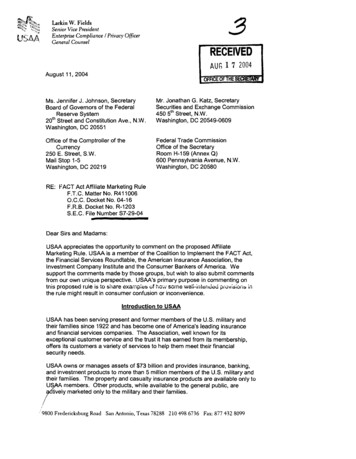
Transcription
-2. ULarkin W. FieldsSenior Vice PresidentEnterprise Compliance 'Privacy OfficerGeneral Counsel :ldLIS A\ZAugust 11,2004Ms. Jennifer J. Johnson, SecretaryBoard of Governors of the FederalReserve System2othStreet and Constitution Ave., N.W.Washington, DC 20551Mr. Jonathan G. Katz, SecretarySecurities and Exchange Commission450 5thStreet, N.W.Washington, DC 20549-0609Office of the Comptroller of theCurrency250 E. Street, S.W.Mail Stop 1-5Washington, DC 20219Federal Trade CommissionOffice of the SecretaryRoom H-159 (Annex Q)600 Pennsylvania Avenue, N.W.Washington, DC 20580RE: FACT Act Affiliate Marketing RuleF.T.C. Matter No. R411006O.C.C. Docket No. 04-16F.R.B. Docket No. R-1203S.E.C. File Number S7-29-04Dear Sirs and Madams:USAA appreciates the opportunity to comment on the proposed AffiliateMarketing Rule. USAA is a member of the Coalition to Implement the FACT Act,the Financial Services Roundtable, the American Insurance Association, theInvestment Company Institute and the Consumer Bankers of America. Wesupport the comments made by those groups, but wish to also submit commentsfrom our own unique perspective. USAA's primary purpose in commenting ontnis proposed rule is to siiare examp:os uf t- o.isome we;;-;iileridocj piov;s; ria;I the rule might result in consumer confusion or inconvenience.Introduction to USAAUSAA has been serving present and former members of the U.S. military andtheir families since 1922 and has become one of America's leading insuranceand financial services companies. The Association, well known for itsexceptional customer service and the trust it has earned from its membership,offers its customers a variety of services to help them meet their financialsecurity needs.USAA owns or manages assets of 73 billion and provides insurance, banking,and investment products to more than 5 million members of the U.S. military andtheir families. The property and casualty insurance products are available only tomembers. Other products, while available to the general public, aremarketed only to the military and their families.I/9800 Fredericksburg Road San Antonio, Texas 78288 210 498 6736 Fax: 877 432 8099
USAA has a relatively unique relationship with its customers. The Association isowned by its members; thus, it does not have the shareholder-drivenobligationsthat publicly-traded and privately-ownedcompanies have. USAA's customersare commonly known within the organization - and self-referentially - as"members" of the USAA family. USAA's goal in serving its membership hasbeen to provide "one-stop" financial services that address the unique needs ofthe military community and to back them with impeccable service that is tailoredto the requirements of the men and women in uniform and their families. USAAmembers demand - and the Association is always striving to provide - a fullrange of highly competitive financial products, which are always offered underthe USAA brand.!JS,f,f!. is nati na!!y rezcs;l&d fcr jt:, r,om:r;itme: ;t :.t ol;ts:nndjr; ;;le, &arservice, which has earned the company numerous quality awards, including theJ.D. Power & Associates Chairman's Award. In a 2002 survey of USAAmembers, 95 percent indicated they were likely or extremely likely to buy fromUSAA in the future. USAA is the highest-ranking financial services company forcustomer advocacy, according to an independent survey conducted by ForresterResearch in 2004.USAA concerns with the proposed ruleUSAA recognizes that the affiliated marketing rule is a complex issue withconflicting goals and overlapping exceptions. Each exception was carefullycrafted by Congress to ensure that existing customers receive all the relevantinformation about products offered by companies they do business with and thatbusinesses are able to fully and accurately respond to communications initiatedby a consumer. To the extent that the regulations narrow the scope of theseexceptions, USAA believes that consumers are harmed more than protected.USAA also believes that the notice to consumers should be as concise and easyto read as possible. These high level concerns are discussed in detail below.Consumer-initiated CommunicationsUSAA believes that the statutory language is plain and unambiguous thatany communication in response to a communication initiated by aconsumer is exempt from the notice and opt-out provisions. The followingrestrictions in the proposed rules will only lead to additional customer confusionand limit USAAs ability to appropriately respond to our members' needs:Contact Information. An example provided in the proposed regulation seems toimply that the consumer must provide contact information at the time of thecommunication in order for this exception to apply. We do not believe that this isconsistent with either the statute or consumer expectations. Our members donot like to repeat information they have already provided, especially basicinformation such as contact information. In a telephone environment, consumersexpect an immediate response to their questions and, in most situations; contactinformation is not even relevant. For example, if a customer calls to inquireabout saving for college expenses through life insurance, it would be extremelyawkward for a customer contact representative to ask for contact informationPage 2
before he or she is permitted to mention other alternative savings products, suchas a 529 investment program available through an affiliate. Consumerssometimes don't understand all of their investment options and expect theirfinancial institution to educate them; it would be a disservice to constraincompanies from fully responding to consumer inquiries. Even if the follow upresponse is through a different channel, such as mail, consumers do not expectto be asked for contact information already provided. We ask the federalagencies to clarify that contact information need not be provided for thisexemption to apply.Call-back messaqes. We also disagree with the federal agencies' conclusionthat a communication is not initiated by the consumer if prompted to call by acall-back message. Consumers are prompted to call through many channels-dii'eci :;ia;'keiii-ig, li;tei:i& oiier 3, outoound call cnrnpai ; ,a r d i . ieai.atccicampaigns that combine several channels. No matter which channel a companyuses to encourage a consumer to contact it, the consumer ultimately makes thedecision whether or not to pick up the phone and call. It is not reasonable orpractical for a company to tailor the conversation based on the means used toencourage the call. In most cases, the employee receiving the call will not knowwhat prompted the customer's phone call. We ask the federal agencies totreat all communications from a consumer the same, regardless of whetherthe consumer was prompted by a call-back message.Communications in response to consumers. We also request that the federalagencies delete the reference to the requirement that the company'smarketing must be "responsive" to the communication from the consumer.This is a very subjective standard that will force companies to either avoid givingappropriate and useful information to consumers, or risk being out of compliancewith this regulation. For example, if a consumer contacts a company aboutstarting a long-term investment plan, a company should be able to respond withinformation on alternative investment vehicles, including those offered by affiliatecompanies. Is this "responsive" to the consumer's inquiry?" It is clearly "inresponse to" the inquiry and represents useful and important information to beconveyed to the consumer. The two examples contained in the proposedregulation do not give sufficient guidance for companies as to what would meetthe standard of "responsive."Marketinn at the reauest of the consumerWe do not agree that preselected check boxes are per se an unacceptablemethod for obtaining consumer authorization. While some preselectedcheck boxes may be misleading or obscure, they can also be clearly andconspicuously presented to consumers. Consumers do not object to preselectedcheck boxes that are used properly, as they reduce the number of clicksnecessary to complete an online transaction. We urge the Commission toreconsider this guidance.The notice and ovt outThe reouired elements. The statute requires only two pieces of information in anopt-out notice: 1) that the consumer may elect to limit affiliate use of eligibilityPage 3
information for sending marketing solicitation and 2) a simple method for optingout. USAA urges the Commission to remove several provisions that add requiredadditional information to the notice and opt-out. We believe that Congressintended for these notices to be short and simple to read; adding elements notrequired by the statute complicates notices and does not provide any consumerbenefit.USAA disagrees with the Commission's approach of requiring a companyto declare a specified time period for the optout election and to state thatthe consumer will be allowed to extend. Congress required only thatconsumers be given an additional chance to renew their opt-out before it expires.By requiring companies to state a specific time period, the Commissioneffectively forces companies to choose the statutory 5 year minimum in order toprescwe tneir opricns. Stating ine 11i1.1eperiad does n proviaeta meaningiulprotection to consumers since they will be given the opportunity to extend theiropt-outs before they expire.USAA also is concerned about the proposal to require a statement of acompany's rule applicable to joint account holders. While the joint accountrule made sense in the context of the Gramm-Leach-Bliley Act privacyrequirements, this statute relates only to the use of information for marketing to aparticular consumer. Companies do not direct marketing to a joint account; theydirect it to an individual. For companies that do not give a GLB opt-out, thisrequirement prevents making a simple one sentence addition to an existingprivacy notice and unnecessarily complicates the notice.The model lanauaae. USAA would prefer to see model language that qualifiesthe type of information affected by the opt-out. Consumers may think that theexamples listed at the end of the sentence represent the only types ofinformation affected by an opt-out. USAA suggests that the model languagedescribe the opt-out information as "credit eligibility information" anddelete the examples at the end of the sentence. USAA also requests thatthe Commission consider providing model language for joint notice by agroup of affiliated companies.USAA requests that the agencies consider setting a compliance date that takesinto account the breadth of companies affected by this rule and their varyingcompliance burdens. Some companies may already offer a broader right to optout of marketing and are ready to comply immediately upon publication of thefinal rule. Others may have to invest in significant complex system modifications,redesign processes and procedures, and train a large workforce. For thesecompanies, six months may not be sufficient time for compliance. Also, sincemany companies may combine this notice with their annual GLB notice, timeshould be allowed for a rollout of notices concurrent with the next GLB notice.USAA suggests that the approach taken in connection with the 1996amendments to the FCRA is appropriate: permit companies to complyearly, but allow for a longer period before requiring compliance.Companies choosing to comply early will have the benefit of federal preemptionPage 4
and assurance that they do not need to comply with multiple state laws on thisissue. Consumers will also benefit from early compliance.USAA appreciates the opportunity to submit comments in this rulemaking.Sincerely yours,L o L 2d-4Larkin FieldsChief Privacy OfficerPage 5
USAA in the future. USAA is the highest-ranking financial services company for customer advocacy, according to an independent survey conducted by Forrester Research in 2004. USAA concerns with the proposed rule USAA recognizes that the affiliated marketing rule is a complex issue with conflicting goals and overlapping exceptions.
